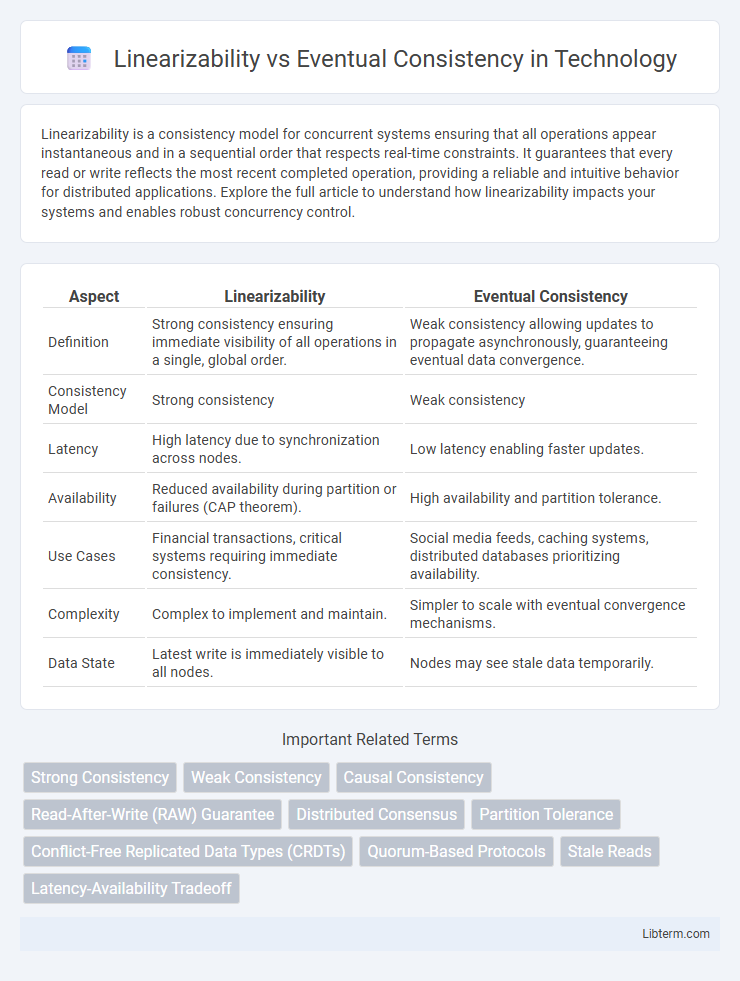Linearizability is a consistency model for concurrent systems ensuring that all operations appear instantaneous and in a sequential order that respects real-time constraints. It guarantees that every read or write reflects the most recent completed operation, providing a reliable and intuitive behavior for distributed applications. Explore the full article to understand how linearizability impacts your systems and enables robust concurrency control.
Table of Comparison
| Aspect | Linearizability | Eventual Consistency |
|---|---|---|
| Definition | Strong consistency ensuring immediate visibility of all operations in a single, global order. | Weak consistency allowing updates to propagate asynchronously, guaranteeing eventual data convergence. |
| Consistency Model | Strong consistency | Weak consistency |
| Latency | High latency due to synchronization across nodes. | Low latency enabling faster updates. |
| Availability | Reduced availability during partition or failures (CAP theorem). | High availability and partition tolerance. |
| Use Cases | Financial transactions, critical systems requiring immediate consistency. | Social media feeds, caching systems, distributed databases prioritizing availability. |
| Complexity | Complex to implement and maintain. | Simpler to scale with eventual convergence mechanisms. |
| Data State | Latest write is immediately visible to all nodes. | Nodes may see stale data temporarily. |
Introduction to Data Consistency Models
Linearizability guarantees that all operations appear instantaneous and in a total order, ensuring strong consistency across distributed systems. Eventual consistency allows for temporary inconsistencies, with guarantees that all replicas will converge to the same state over time. These data consistency models address trade-offs between system availability, latency, and consistency in distributed database design.
What is Linearizability?
Linearizability is a strong consistency model in distributed systems ensuring that all operations appear instantaneous and in a single global order, reflecting real-time ordering across all nodes. It guarantees that once a write completes, any subsequent read will see that write or a later one, maintaining a strict consistency view. This model is crucial for applications requiring immediate consistency and precise synchronization, such as financial transaction systems and distributed databases.
Understanding Eventual Consistency
Eventual consistency ensures that all copies of a distributed data store will converge to the same value if no new updates are made, prioritizing availability and partition tolerance over immediate consistency. This model allows applications to continue operating smoothly despite network partitions or delays, making it ideal for systems requiring high availability like cloud storage and large-scale web applications. Understanding eventual consistency involves recognizing the trade-offs between immediate data accuracy and system responsiveness in distributed database architectures.
Key Differences Between Linearizability and Eventual Consistency
Linearizability provides strong consistency by ensuring that all operations appear instantaneously and in a single, globally agreed-upon order, making it suitable for systems requiring immediate correctness. Eventual consistency allows temporary inconsistencies by permitting nodes to diverge, with the system guaranteeing convergence over time, optimizing for availability and partition tolerance in distributed environments. The key difference lies in linearizability's strict real-time operation ordering versus eventual consistency's relaxed order with eventual data convergence.
Real-World Use Cases for Linearizability
Linearizability ensures operations on distributed systems appear instantaneous and consistent, critical for financial transactions, inventory management, and real-time bidding platforms where accuracy and immediate state reflection prevent data anomalies. Systems like Google Spanner and Apache ZooKeeper implement linearizability to guarantee strong consistency and fault tolerance in globally distributed environments. This model supports applications demanding strict correctness, such as banking ledger updates and stock trading systems, where even minor inconsistencies can lead to significant operational risks.
When to Choose Eventual Consistency
Eventual consistency is ideal for distributed systems prioritizing high availability and partition tolerance, especially in scenarios where temporary data inconsistencies are acceptable, such as social media feeds or DNS services. It supports systems with frequent updates across multiple nodes by allowing updates to propagate asynchronously, reducing latency and improving performance under network partitions. Choosing eventual consistency maximizes responsiveness and scalability when strict ordering and immediate consistency are not critical for the application's correctness.
Trade-offs: Performance vs Consistency
Linearizability guarantees strong consistency by ensuring all operations appear instantaneously and in a total order, which can significantly increase latency and reduce system throughput in distributed environments. Eventual consistency offers higher performance and availability by allowing temporary inconsistencies, with updates propagating asynchronously to achieve eventual uniformity across replicas. The trade-off involves choosing linearizability for critical applications requiring immediate consistency versus eventual consistency for scalable systems prioritizing low latency and fault tolerance.
Impact on System Availability and Partition Tolerance
Linearizability ensures strong consistency by requiring all operations to appear instantaneous and globally ordered, which often reduces system availability during network partitions due to the need for coordination. Eventual consistency sacrifices immediate consistency to enhance availability and partition tolerance, allowing systems to continue operating under network failures with the guarantee that all replicas will converge over time. Systems prioritizing high availability and partition tolerance, such as those following the AP model in the CAP theorem, typically adopt eventual consistency to remain responsive despite network splits.
Popular Systems Using Linearizability and Eventual Consistency
Popular systems using linearizability include Google Spanner, which provides global strong consistency and external consistency by synchronizing clocks across data centers, and Apache Zookeeper, known for distributed coordination with strict linearizable guarantees. Eventual consistency is employed by Amazon DynamoDB and Apache Cassandra, enabling high availability and partition tolerance by allowing updates to propagate asynchronously across replicas. These systems balance consistency and performance based on their specific use cases, with linearizability favored in scenarios requiring immediate consistency and eventual consistency adopted for scalable, highly available distributed databases.
Conclusion: Selecting the Right Consistency Model
Selecting the right consistency model depends on application requirements for latency, availability, and correctness. Linearizability guarantees strong consistency with real-time operation ordering, ideal for critical systems requiring immediate data accuracy. Eventual consistency offers higher availability and lower latency for distributed systems where temporary inconsistencies are acceptable and data convergence is eventual.
Linearizability Infographic

 libterm.com
libterm.com